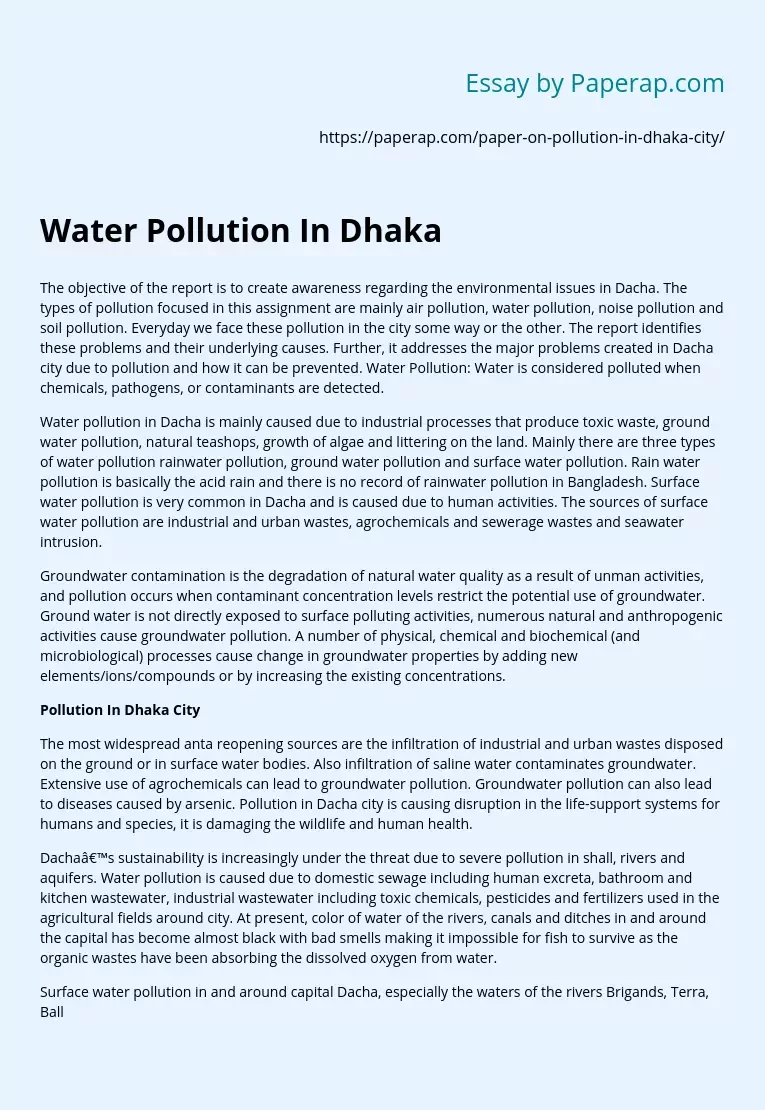Water Pollution In Dhaka
The objective of the report is to create awareness regarding the environmental issues in Dacha. The types of pollution focused in this assignment are mainly air pollution, water pollution, noise pollution and soil pollution. Everyday we face these pollution in the city some way or the other. The report identifies these problems and their underlying causes. Further, it addresses the major problems created in Dacha city due to pollution and how it can be prevented. Water Pollution: Water is considered polluted when chemicals, pathogens, or contaminants are detected.
Water pollution in Dacha is mainly caused due to industrial processes that produce toxic waste, ground water pollution, natural teashops, growth of algae and littering on the land. Mainly there are three types of water pollution rainwater pollution, ground water pollution and surface water pollution. Rain water pollution is basically the acid rain and there is no record of rainwater pollution in Bangladesh. Surface water pollution is very common in Dacha and is caused due to human activities.
The sources of surface water pollution are industrial and urban wastes, agrochemicals and sewerage wastes and seawater intrusion.
Groundwater contamination is the degradation of natural water quality as a result of unman activities, and pollution occurs when contaminant concentration levels restrict the potential use of groundwater. Ground water is not directly exposed to surface polluting activities, numerous natural and anthropogenic activities cause groundwater pollution. A number of physical, chemical and biochemical (and microbiological) processes cause change in groundwater properties by adding new elements/ions/compounds or by increasing the existing concentrations.
Pollution In Dhaka City
The most widespread anta reopening sources are the infiltration of industrial and urban wastes disposed on the ground or in surface water bodies. Also infiltration of saline water contaminates groundwater. Extensive use of agrochemicals can lead to groundwater pollution. Groundwater pollution can also lead to diseases caused by arsenic. Pollution in Dacha city is causing disruption in the life-support systems for humans and species, it is damaging the wildlife and human health.
Dacha’s sustainability is increasingly under the threat due to severe pollution in shall, rivers and aquifers. Water pollution is caused due to domestic sewage including human excreta, bathroom and kitchen wastewater, industrial wastewater including toxic chemicals, pesticides and fertilizers used in the agricultural fields around city. At present, color of water of the rivers, canals and ditches in and around the capital has become almost black with bad smells making it impossible for fish to survive as the organic wastes have been absorbing the dissolved oxygen from water.
Surface water pollution in and around capital Dacha, especially the waters of the rivers Brigands, Terra, Ball and Tong canal have been threatening the supply of safe drinking water and public health of over 10 million city dwellers. Because of the damage of the sewerage lines in different places, the WAS sewerage reattempt plant at Page in Maryanne receives only one-third of its capacity in dry season, 85 percent of the drinking water supply come from ground water and the rest is provided by treating surface waters.
People in the city are surviving as they use drinking water after boiling to free it from contamination. Industries at Postal, Faithful, and a huge number of tanneries at Hazarding have been polluting the river Brigands. These wastes contains sulfuric acid, chromium, ammonium sulfate, chloride and calcium oxides. The industries are the major source of pollution of the Terra River while many others dump their wastes in the rivers Ball and Statistical. Thus, measures should be taken to prevent water pollution in Dacha city.
Water Pollution In Dhaka. (2019, Dec 05). Retrieved from https://paperap.com/paper-on-pollution-in-dhaka-city/

